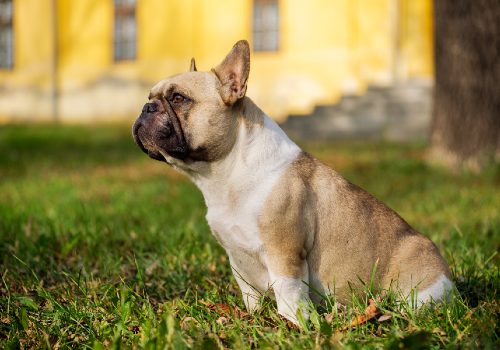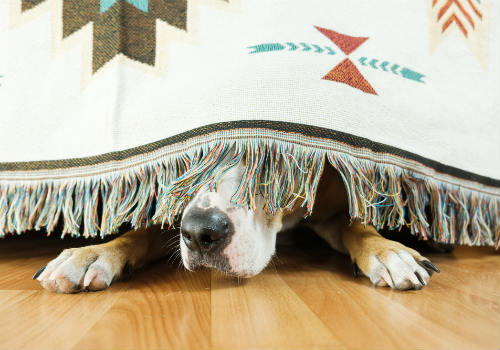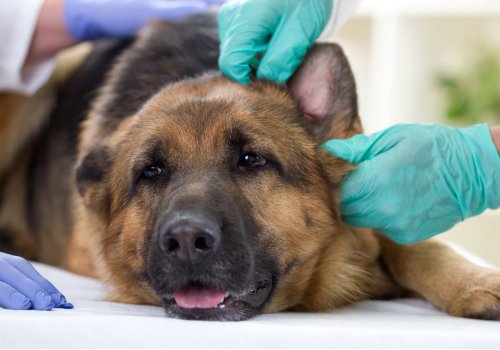Be they floppy, pointy, or somewhere in between, your dog’s ears are critical to his communication.
We humans may not be able to express our emotions via our ears, but dogs can manipulate their ears in many different ways to add nuance to their body language.
And that’s especially true when they put their ears back.
So what is your dog trying to tell you when those ears go back?
It could be many different things — here’s how to tell exactly which one it is.
9 Reasons Why Your Dog Puts His Ears Back

Your Dog Wants to Hear What’s Going on Behind Him
In the world of canine body language, sometimes the simplest explanation is the correct one. Your dog’s ears may be pointing back because there’s something going on behind him and he wants to hear it more clearly.
Dog ears tend to be large compared to their heads in order to capture and funnel sound more effectively. They also swivel to capture sounds coming from different directions.
If your dog is sitting in front of you and you start having a phone conversation, his ears may point back so he can hear what you’re saying. The noise isn’t immediately interesting enough to get his full attention, but he’s still curious enough to want a closer to listen.
Your Dog Is Feeling Content and Relaxed
If your dog’s ears aren’t naturally pointed, then it’s normal for them to point back slightly while he’s at rest — it’s just in their nature to lay back a little. Long, floppy ears may even turn inside out during peaceful times!
Examine the rest of your dog’s body language to determine if contentment is the reason for his pushed-back ears.
A content dog will have a relaxed face, with no brow furrowing, lip curling, or tense jaw. His limbs and posture will also be relaxed, and he won’t be looking around frantically or hiding his tail between his legs.
On the other hand, if your dog has naturally pointed ears, if they’re pinned back flat against his head, or if the rest of his body language seems tense, contentment probably isn’t the reason for his pushed-back ears.
Your Dog Is Happy to See You

Have you ever gotten home to find your dog wagging his tail and wiggling his body into a U shape?
At first glance, he looks excited to see you, but then you notice that his ears are pushed back. What’s up with the mixed signals?
Thankfully, it’s nothing to be alarmed about, just another of the many quirks of dog communication. It’s thought that dogs do this because they know they might startle you with their wagging and wiggling, and they want to indicate to you that they mean no harm.
This type of behavior probably makes more sense to other dogs than it does to us. As we’re about to see, friendly submission is a fundamental part of dog relationships.
Your Dog Is Trying to Appease a New Dog
Dogs instinctively maintain a hierarchy amongst themselves, including with any new dogs they meet. Their body language during their introduction can make or break the relationship, and it provides a lot of insight into how your dog views himself in comparison to the other dog.
Say you’re walking your dog down your block and you encounter your new neighbor and his dog. Your dog has been here for a while and knows that the block is his turf, so he holds himself confidently, keeping his ears upright and his posture tall.
The new dog reads this body language and understands that your dog is the boss. She’s not about to step on any paws, so she puts her ears back as a sign of appeasement — she’s saying, “I can see that you’re the one in charge here and I respect that. I’m not a threat and I don’t want any trouble with you.”
Other types of appeasement behavior include lack of eye contact, low posture, and extended tongue. Some dogs may even roll over onto their backs, exposing their bellies in a gesture of submission.
Be warned that in this type of interaction, pushed-back ears can also indicate deeper anxiety, fear, or even aggression. Keep reading to find out how to tell if this is the case.
Your Dog Is Feeling Anxious or Nervous
Fireworks, vet visits, loud music from the party next door — all manner of things can provoke anxiety or nervousness in your dog. Often, the most visible sign of this is pushed-back ears.
If your dog’s pushed-back ears are related to anxiety, you may see him yawning or licking his lips repeatedly. His face will be tense, the whites of his eyes may be showing and he may hold his tail close to his body.
Use the position of the ears to gauge the intensity of your dog’s anxiety: a little push back indicates slight wariness, while ears that are put back all the way suggest extreme nervousness.
Your Dog Is Afraid of Something

Fear goes beyond anxiety or nervousness, resulting in various behaviors that are often accompanied by pushed-back or flattened ears.
A fearful dog may cower or hide in a corner or under furniture, covering his face with his paws and tucking his tail between his legs. He may also growl, bark or whine involuntarily.
Some dogs pant or drool when they’re afraid, and many shake or tremble uncontrollably. In extreme cases, fear can cause a dog to lose control over his bladder and bowels.
If your dog exhibits pushed-back ears along with any of these behaviors, take immediate action to calm him down and get him away from the source of the fear. Otherwise, his fear could escalate into aggression, as we’re about to see…
Your Dog Is About to Bite
Unchecked fear or irritation provokes a physiological response in dogs that frequently results in a bite. The combination of stress hormones, muscle tension, and sensory overload puts the dog in fight-or-flight mode, and all too often, the dog chooses the former.
In the moments before a dog bites, he bares his teeth, stiffens his body, and stares intently at the target of his ire. You’ll see his ears completely flatten back against his head, and if you don’t heed this warning, he’ll lunge and bite.
Some dog behaviorists believe that dogs pin their ears back before biting in order to keep them out of the way of sharp teeth and claws. Dogs rely largely on their hearing to make their way through the world, so it makes sense that they’d reflexively protect them in a fight.
Of course, the best thing you can do is prevent your dog from reaching this level of stress, to begin with. But since that’s not always possible, watch those ears and give him his space if you see them flatten out.
Your Dog Is Feeling Down in the Dumps
Dogs get attached to their owners and families, and that’s a big part of what we love about them.
But that attachment can lead to sadness when, for whatever reason, you need to go somewhere and you can’t take your dog with you.
When you head out to go to work in the morning, you may hear your dog whining and pawing at the door behind you. If you were a fly on the wall, you’d likely see his tail low and his ears tucked down against his head.
These are all signs of sadness in dogs, and you may notice them at other times too. Your dog’s ears may flatten when you won’t let him play with your neighbor’s dogs, or when you put his favorite toy away for the day.
And as highly sensitive creatures, dogs also get sad when their owners are sad. So if you’re going through a rough time, don’t be surprised if your dog puts his head in your lap and holds his ears back — he’s empathizing with you.
Thankfully, dogs don’t usually stay sad for very long, and those ears should spring right back up in due time. Love, attention, and a physical outlet will go a long way towards bringing back your pup’s positive attitude.
Your Dog Has an Ear Infection or Injury

Canine ear infections are extremely common, affecting approximately 20% of dogs. They’re caused by yeast and bacteria feeding on built-up dirt, oil, hair, and debris inside the ear canal.
Ear injuries are also common due to the delicate skin on and around the ears. Dogs that play or fight with other dogs are especially prone to an ear injury.
Both ear infection and injury can cause dogs to push their ears back likely in an attempt to avoid worsening the pain or further injuring the ears. In these cases, pushed-back ears are typically accompanied by ear rubbing or scratching, head shaking, redness, discharge, or an odor coming from the ears.
Ear infections and injuries are uncomfortable and painful, and they can develop into much more serious conditions if they’re not treated. If you notice any of the symptoms above, whether or not your dog’s ears are also pushed back, see a vet to identify and treat the problem as soon as possible.
